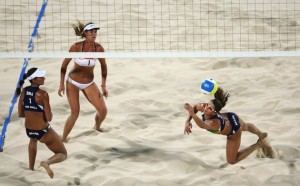It's a good time to be a female athlete. As the NCAA women's basketball tournament winds down, we are left with the stories and legacies of serious athletic stars like Elena Delle Donne (with her interesting and brave back story) and Stanford's Ogwumike sisters. Notre Dame's Skylar Diggins has emerged as a star who transcends the impressive boundaries of her sport.
Just as basketball concludes Olympic athletes in various fields gear up. For the first time ever it appears that every nation participating in the 2012 Games will send at least one female athlete to London. That includes Muslim countries like Saudi Arabia, Brunei, and Qatar. This is a significant development to be celebrated-- as is the fact that certain sports are loosening restrictions on female athletic attire. To the applause (and, I suppose, disappointment to some) women's beach volleyball players no longer have to compete in bikinis. Given how much grief we give beauty pageants for the swimsuit portion of the competition, it's amazing this rule change took so long and hasn't previously met with more resistance.
 Just because women won't be playing in bikinis and skirts doesn't mean that they are any less tough-- or less girly for that matter. I absolutely loved this article on 22-year-old weight lifter Holley Mangold. Mangold, a 374-pound weightlifter (and brother to NFL star Nick Mangold), just qualified to represent the US at the Olympics this summer. While at the Trials earlier this month she rocked a "girly" hair-do and painted her nails using OPI color "It's All Greek to Me."
Just because women won't be playing in bikinis and skirts doesn't mean that they are any less tough-- or less girly for that matter. I absolutely loved this article on 22-year-old weight lifter Holley Mangold. Mangold, a 374-pound weightlifter (and brother to NFL star Nick Mangold), just qualified to represent the US at the Olympics this summer. While at the Trials earlier this month she rocked a "girly" hair-do and painted her nails using OPI color "It's All Greek to Me."
Given her Olympic-sized goal this seems a most appropriate choice. Holley, who describes herself as "extremely manly," says she can also be girly, which she chooses to demonstrate through small fashion choices like her hairstyle and nails (not dissimilar to Skylar Diggins' approach to her hair).
Female athletes clearly have some sartorial flexibility to demonstrate a range of femininities. But it seems that they may also have more flexibility to demonstrate a range of athletic skills as well. This article on superstar two-sport athlete Melanie Baskind-- who plays on and co-captains both the varsity lacrosse and soccer teams at Harvard-- mentions that: "There may be a nascent drift at Harvard toward two-letter women. Four of Baskind’s lacrosse teammates also play field hockey, and a soccer cohort swims for the water-polo squad. Ivy League rules, which limit practices and off-season play days, make dual citizenship more manageable." This at a time when two-letter men are becoming less common. Is this a good or a bad thing for women? The cross-training would seem to be helpful in preventing burn-out in a particular sport (note that Elena Delle Donne, mentioned above, briefly gave up basketball to play college volleyball-- though never at the same time), along with injuries. Or perhaps as more and more female athletes rise up through the ranks two-sport collegiate females will go the way of two-sport collegiate males?
One school where collegiate female athletes haven't made a big enough dent is Texas A&M. Would you believe that they have never had a female cheerleader? It's true-- though their definition of cheerleader is a bit different. "Yell leaders" are all men who cheer from the sidelines (and, yes, Rick Perry was one as an undergraduate). They are voted on by the student body, so junior Samantha Ketcham waged a very public, vocal campaign, which received a lot of press. Despite her loud voice, she didn't win. Perhaps next year there will be even more candidates... rocking some OPI red nail polish.
